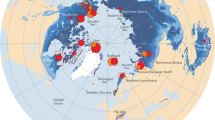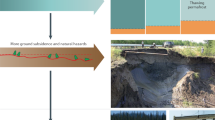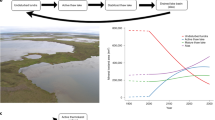Abstract
Extensive degradation of near-surface permafrost is projected during the twenty-first century1, which will have detrimental effects on northern communities, ecosystems and engineering systems. This degradation is predicted to have consequences for many processes, which previous modelling studies have suggested would occur gradually. Here we project that soil moisture will decrease abruptly (within a few months) in response to permafrost degradation over large areas of the present-day permafrost region, based on analysis of transient climate change simulations performed using a state-of-the-art regional climate model. This regime shift is reflected in abrupt increases in summer near-surface temperature and convective precipitation, and decreases in relative humidity and surface runoff. Of particular relevance to northern systems are changes to the bearing capacity of the soil due to increased drainage, increases in the potential for intense rainfall events and increases in lightning frequency. Combined with increases in forest fuel combustibility, these are projected to abruptly and substantially increase the severity of wildfires, which constitute one of the greatest risks to northern ecosystems, communities and infrastructures. The fact that these changes are projected to occur abruptly further increases the challenges associated with climate change adaptation and potential retrofitting measures.
This is a preview of subscription content, access via your institution
Access options
Access Nature and 54 other Nature Portfolio journals
Get Nature+, our best-value online-access subscription
$29.99 / 30 days
cancel any time
Subscribe to this journal
Receive 12 print issues and online access
$209.00 per year
only $17.42 per issue
Buy this article
- Purchase on Springer Link
- Instant access to full article PDF
Prices may be subject to local taxes which are calculated during checkout




Similar content being viewed by others
Data availability
The datasets generated and analysed are available from the corresponding author on reasonable request.
Code availability
The code used for analysis is available from the corresponding author on reasonable request.
References
Koven, C. D., Riley, W. J. & Stern, A. Analysis of permafrost thermal dynamics and response to climate change in the CMIP5 Earth system models. J. Clim. 26, 1877–1900 (2013).
Miller, G. H. et al. Arctic amplification: can the past constrain the future? Quat. Sci. Rev. 29, 1779–1790 (2010).
Woo, M. K., Kane, D. L., Carey, S. K. & Yang, D. Q. Progress in permafrost hydrology in the new millennium. Permafr. Periglac. Process. 19, 237–254 (2008).
White, D. et al. The Arctic freshwater system: changes and impacts. J. Geophys. Res. Biogeosci. 112, G04S54 (2007).
Jorgenson, M. T. et al. Reorganization of vegetation, hydrology and soil carbon after permafrost degradation across heterogeneous boreal landscapes. Environ. Res. Lett. 8, 035017 (2013).
Liljedahl, A. K. et al. Pan-Arctic ice-wedge degradation in warming permafrost and its influence on tundra hydrology. Nat. Geosci. 9, 312–318 (2016).
Perreault, N., Levesque, E., Fortier, D. & Lamarque, L. J. Thermo-erosion gullies boost the transition from wet to mesic tundra vegetation. Biogeosciences 13, 1237–1253 (2016).
Drijfhout, S. et al. Catalogue of abrupt shifts in Intergovernmental Panel on Climate Change climate models. Proc. Natl Acad. Sci. USA 112, E5777–E5786 (2015).
Avis, C. A., Weaver, A. J. & Meissner, K. J. Reduction in areal extent of high-latitude wetlands in response to permafrost thaw. Nat. Geosci. 4, 444–448 (2011).
Lenton, T. M. Arctic climate tipping points. Ambio 41, 10–22 (2012).
Wrona, F. J. et al. Transitions in Arctic ecosystems: ecological implications of a changing hydrological regime. J. Geophys. Res. Biogeosci. 121, 650–674 (2016).
Lawrence, D. M., Koven, C. D., Swenson, S. C., Riley, W. J. & Slater, A. G. Permafrost thaw and resulting soil moisture changes regulate projected high-latitude CO2 and CH4 emissions. Environ. Res. Lett. 10, 094011 (2015).
Streletskiy, D. A., Shiklomanov, N. I. & Nelson, F. E. Permafrost, infrastructure, and climate change: a GIS-based landscape approach to geotechnical modeling. Arct. Antarct. Alp. Res. 44, 368–380 (2012).
Magi, B. I. Global lightning parameterization from CMIP5 climate model output. J. Atmos. Ocean. Technol. 32, 434–452 (2015).
Stocks, B. J. et al. Large forest fires in Canada, 1959–1997. J. Geophys. Res. Atmos. 107, 8149 (2002).
McGee, T., McFarlane, B. & Tymstra, C. in Wildfire Hazards, Risks and Disasters (eds Shroder, J. F. & Paton, D.) 35–58 (Elsevier, 2015).
van Wagner, C. Development and Structure of the Canadian Forest Fire Weather Index System. (Canadian Forestry Service, 1987).
Lawson, B. D. & Armitage, O. Weather Guide for the Canadian Forest Fire Danger Rating System (Canadian Forest Service, 2008).
Prein, A. F. et al. A review on regional convection-permitting climate modeling: demonstrations, prospects, and challenges. Rev. Geophys. 53, 323–361 (2015).
Schleussner, C.-F. et al. Science and policy characteristics of the paris agreement temperature goal. Nat. Clim. Change 6, 827–835 (2016).
Cote, J. et al. The operational CMC–MRB global environmental multiscale (GEM) model. Part I: design considerations and formulation. Mon. Weather Rev. 126, 1373–1395 (1998).
Teufel, B. et al. Investigation of the 2013 Alberta flood from weather and climate perspectives. Clim. Dyn. 48, 2881–2899 (2017).
Verseghy, D. CLASS–The Canadian Land Surface Scheme v.3.5 Technical Documentation v.1 (Environment Canada, 2011).
Teufel, B., Sushama, L., Arora, V. K. & Verseghy, D. Impact of dynamic vegetation phenology on the simulated pan-Arctic land surface state. Clim. Dyn. 52, 373–388 (2019).
Dee, D. P. et al. The ERA-Interim reanalysis: configuration and performance of the data assimilation system. Q. J. R. Meteorol. Soc. 137, 553–597 (2011).
Nachtergaele, F. O. et al. Harmonized World Soil Database Version 1.2 (FAO, 2012).
Pelletier, J. D. et al. Global 1-km Gridded Thickness of Soil, Regolith, and Sedimentary Deposit Layers (ORNL Distributed Active Archive Center, 2016).
Letts, M. G., Roulet, N. T., Comer, N. T., Skarupa, M. R. & Verseghy, D. L. Parametrization of peatland hydraulic properties for the Canadian land surface scheme. Atmos. Ocean 38, 141–160 (2000).
Pettitt, A. N. A non-parametric approach to the change-point problem. J. R. Stat. Soc. C 28, 126–135 (1979).
Bowman, A. W., Pope, A. & Ismail, B. Detecting discontinuities in non-parametric regression curves and surfaces. Stat. Comput. 16, 377–390 (2006).
Bates, B. C., Chandler, R. E. & Bowman, A. W. Trend estimation and change point detection in individual climatic series using flexible regression methods. J. Geophys. Res. Atmos. 117, D16106 (2012).
Hurvich, C. M., Simonoff, J. S. & Tsai, C. L. Smoothing parameter selection in non-parametric regression using an improved Akaike information criterion. J. R. Stat. Soc. B 60, 271–293 (1998).
Acknowledgements
This research was funded by the Natural Sciences and Engineering Research Council of Canada (grant no. RGPIN-2019-05238), the Trottier Institute for Sustainability in Engineering and Design and the McGill Sustainability Systems Initiative. The GEM simulations in this study were performed on supercomputers managed by Calcul Québec and Compute Canada.
Author information
Authors and Affiliations
Contributions
B.T. and L.S. designed the study and analysis. B.T. performed the climate model simulations, analysed the data and wrote the manuscript. Both authors contributed to interpreting the results and made substantial improvements to the manuscript.
Corresponding author
Ethics declarations
Competing interests
The authors declare no competing interests.
Additional information
Peer review information Nature Climate Change thanks Bryson Bates and the other, anonymous, reviewer(s) for their contribution to the peer review of this work.
Publisher’s note Springer Nature remains neutral with regard to jurisdictional claims in published maps and institutional affiliations.
Supplementary information
Supplementary Information
Supplementary Figs. 1–8 and references
Rights and permissions
About this article
Cite this article
Teufel, B., Sushama, L. Abrupt changes across the Arctic permafrost region endanger northern development. Nat. Clim. Chang. 9, 858–862 (2019). https://doi.org/10.1038/s41558-019-0614-6
Received:
Accepted:
Published:
Issue Date:
DOI: https://doi.org/10.1038/s41558-019-0614-6
This article is cited by
-
Land cover changes across Greenland dominated by a doubling of vegetation in three decades
Scientific Reports (2024)
-
Permafrost degradation increases risk and large future costs of infrastructure on the Third Pole
Communications Earth & Environment (2022)
-
Current Siberian heating is unprecedented during the past seven millennia
Nature Communications (2022)
-
High-resolution modelling of climatic hazards relevant for Canada’s northern transportation sector
Climate Dynamics (2022)
-
Climatology of Arctic temperature inversions in current and future climates
Theoretical and Applied Climatology (2022)



